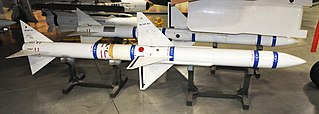
The AIM-7 Sparrow is an American, medium-range semi-active radar homing air-to-air missile operated by the United States Air Force, United States Navy, and United States Marine Corps, as well as other various air forces and navies. Sparrow and its derivatives were the West's principal beyond visual range (BVR) air-to-air missile from the late 1950s until the 1990s. It remains in service, although it is being phased out in aviation applications in favor of the more advanced AIM-120 AMRAAM.

The AGM-65 Maverick is an air-to-ground missile (AGM) designed for close air support. It is the most widely produced precision-guided missile in the Western world, and is effective against a wide range of tactical targets, including armor, air defenses, ships, ground transportation and fuel storage facilities.

Saab AB is a Swedish aerospace and defence company, founded in 1937. Headquartered in Stockholm, the development and the manufacturing is undertaken in Linköping. Saab produced automobiles from 1947 until 1990 when the automobile division was spun off as Saab Automobile, a joint venture with General Motors. The joint venture ended in 2000 when GM took complete ownership. From 1968 onwards the company was in a merger with commercial vehicle manufacturer Scania-Vabis, known as Saab-Scania. The two were de-merged in 1995 by the new owners, Investor AB. Despite the demerger, both Saab and Scania share the right to use the griffin logo, which originates from the coat of arms of the Swedish region of Scania.

The Saab 37 Viggen is a retired Swedish single-seat, single-engine, short-medium range multirole combat aircraft. Development work on the type was initiated at Saab in 1952 and, following the selection of a radical delta wing configuration, the resulting aircraft performed its first flight on 8 February 1967 and entered service in 21 June 1971. It was the first canard design produced in quantity and arguably the most modern/advanced combat aircraft in Europe at the time of introduction, featuring an airborne digital central computer with integrated circuits for its avionics, the world's first of its kind, automating and taking over tasks previously requiring a navigator/copilot, facilitating handling in tactical situations where, among other things, high speeds and short decision times determined whether attacks would be successful or not, a system not surpassed until the introduction of the Panavia Tornado into operational service in 1981.
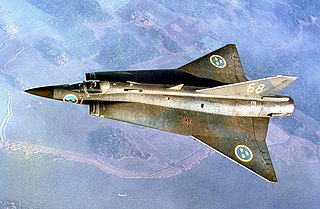
The Saab 35 Draken is a Swedish fighter-interceptor developed and manufactured by Svenska Aeroplan Aktiebolaget (SAAB) between 1955 and 1974. Development of the Saab 35 Draken started in 1948 as the Swedish air force future replacement for the then also in development Saab 29 Tunnan dayfighter and Saab 32B Lansen night fighter. It featured an innovative but unproven double delta wing, which led to the creation of a sub-scale test aircraft, the Saab 210, which was produced and flown to test this previously-unexplored aerodynamic feature. The full-scale production version entered service with frontline squadrons of the Swedish Air Force on 8 March 1960. It received the designation Flygplan 35 and was produced in several variants and types, most commonly as a fighter type with the prefix J, standing for Jaktflygplan (Pursuit-aircraft), the Swedish term for fighter aircraft.

The IRIS-T is a medium range infrared homing missile available in both air-to-air and ground defence surface-to-air variants. It also is called AIM-2000.

An air-to-air missile (AAM) is a missile fired from an aircraft for the purpose of destroying another aircraft. AAMs are typically powered by one or more rocket motors, usually solid fueled but sometimes liquid fueled. Ramjet engines, as used on the Meteor, are emerging as propulsion that will enable future medium-range missiles to maintain higher average speed across their engagement envelope.
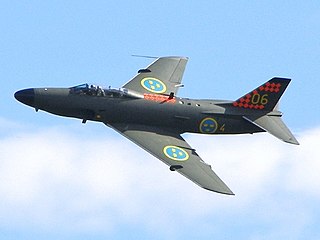
The Saab 32 Lansen is a two-seat, transonic military aircraft designed and manufactured by Saab AB from 1955 to 1960 for the Swedish Air Force (Flygvapnet). Three principal variants of the Lansen were built for attack, fighter, and reconnaissance. During its long operational life, the Saab 32 also served in the electronic warfare role and as a target-tug.

The Hughes AIM-4 Falcon was the first operational guided air-to-air missile of the United States Air Force. Development began in 1946; the weapon was first tested in 1949. The missile entered service with the USAF in 1956.

The AIM-26 Falcon was a larger, more powerful version of the AIM-4 Falcon air-to-air missile built by Hughes. It is the only guided American air-to-air missile with a nuclear warhead to be produced; the unguided AIR-2 Genie rocket was also nuclear-armed.
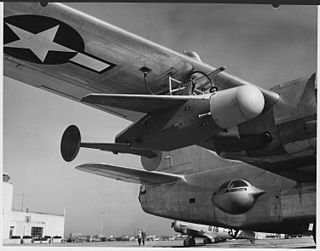
Active radar homing (ARH) is a missile guidance method in which a missile contains a radar transceiver and the electronics necessary for it to find and track its target autonomously. The NATO brevity code for an air-to-air active radar homing missile launch is fox three.

An air-to-surface missile (ASM) or air-to-ground missile (AGM) is a missile designed to be launched from military aircraft at targets on land or sea. There are also unpowered guided glide bombs not considered missiles. The two most common propulsion systems for air-to-surface missiles are rocket motors, usually with shorter range, and slower, longer-range jet engines. Some Soviet-designed air-to-surface missiles are powered by ramjets, giving them both long range and high speed.

The AGM-12 Bullpup is a short-range air-to-ground missile developed by Martin Marietta for the US Navy. It is among the earliest precision guided air-to-ground weapons and the first to be mass produced. It first saw operational use in 1959 on the A-4 Skyhawk, but soon found use on the A-6 Intruder, F-100 Super Sabre, F-105 Thunderchief, F-4 Phantom II, F-8 Crusader, and P-3 Orion in both Navy and US Air Force service, as well as NATO allies. The weapon was guided manually via a small joystick in the aircraft cockpit, which presented a number of problems and its ultimate accuracy was on the order of 10 metres (33 ft), greater than desired. In the 1960s it was increasingly supplanted by fully automatic weapons like the AGM-62 Walleye and AGM-65 Maverick.

In aerobatics, the cobra maneuver, also called dynamic deceleration, among other names, is a dramatic and demanding maneuver in which an airplane flying at a moderate speed abruptly raises its nose momentarily to a vertical and slightly past vertical attitude, causing an extremely high angle of attack and momentarily stalling the plane, making a full-body air brake before dropping back to normal position, during which the aircraft does not change effective altitude.

The RBS 15 is a long-range fire-and-forget surface-to-surface and air-to-surface anti-ship missile. The later version Mk. III has the ability to attack land targets as well. The missile was developed by the Swedish company Saab Bofors Dynamics.
This is a list of weapons used by the Swedish Air Force.

The RB-04 is a long-range sea skimming fire-and-forget air-to-surface, anti-ship missile. The missile was known as the "RB-304" during development and early service years.
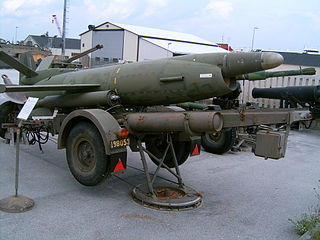
Robot 08 was a Swedish anti-ship missile. It was the first operational ship-based anti-ship missiles. The design was a development of the French Nord Aviation CT20 target missile and was manufactured by Saab. The project to develop the weapon was initiated in the 1950s and the missile entered service in 1966 aboard the Halland-class destroyers, later also serving with the Swedish Coastal Artillery. Guidance was via radio command and active radar homing. The missile was replaced by the RBS-15, being retired in 1995.
Television guidance (TGM) is a type of missile guidance system using a television camera in the missile or glide bomb that sends its signal back to the launch platform. There, a weapons officer or bomb aimer watches the image on a television screen and sends corrections to the missile, typically over a radio control link. Television guidance is not a seeker because it is not automated, although semi-automated systems with autopilots to smooth out the motion are known. They should not be confused with contrast seekers, which also use a television camera but are true automated seeker systems.


















